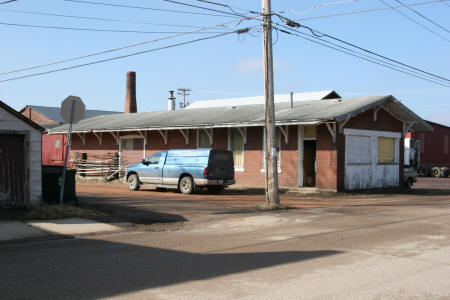 |
Owen, WI Continues as Important Rail Center
Story & Photos by Kris Leonhardt.
~Part 2~
The Owen Wisconsin Central (WC) depot boomed with activity in the early 1900's. The WC rail had been expanded, with a line running north from the city to Duluth. Travelers and merchants could now take advantage of passenger and freight service in as many as four directions.
Residents of Owen and surrounding communities often took advantage of a daily train running to and from Ladysmith. Nicknamed the "Scoot", the train provided a means for travel to trade goods or visit friends and relatives.
The Minneapolis, St. Paul, & Sault Ste. Marie Railway Company (Soo Line) soon recognized the value of the WC line and acquired all of the WC outstanding stock and, in 1909, entered into a lease with the WC.
All of Wisconsin Central's equipment used during the lease, was painted with the Soo Line dollar sign company logo, but retained the maroon and gold colors previously used by the WC. The small initials "WC", along with the number series, were painted on each car and locomotive to indicate ownership by the Wisconsin Central.
In 1910, a 19.9 mile line was constructed from Spencer to Owen, on the line running north from Marshfield. The new line provided a shortcut so train traffic would not have to travel through Colby, Abbotsford, and Curtiss, to reach Owen.
Train traffic on the old line, running from Spencer to Abbotsford and points further north continued, but traffic on the line from Abbotsford to Owen eventually ceased. The line was abandoned and the tracks eventually removed; however, a portion of the track, including the turnoff, can still be found today, in the city of Abbotsford.
The Owen WC depot (now belonging to the Canadian National) also exists as a testament to the Abbotsford-Owen line. The depot, which once sat parallel with the Abbotsford-Owen line, now stands at a odd angle in relation to the current line.
Trains running in four directions, began to offer six passenger trains daily. Passenger service, along with the already existing freight and mail service, caused train traffic to flourish in the community and throughout the rail line.
By the end of the 1930's, the WC and the Soo Line were experiencing financial troubles. The "Great Depression" had hit the companies hard and they struggled to stay operating.
In addition, the introduction of the automobile had started out slow, but as popularity soared there was less and less need for passenger service. In 1900, just one in 9,500 Americans owned a car. By 1960, that number rose to one in three.
In the 1950's, railroad companies worked hard to entice people to use train passenger service. New, and improved, cars were purchased as the companies promoted comfort.
While passenger service began to decline, freight service exploded. The transportation of iron ore and pulpwood gave the Soo Line and the WC new hope.
In 1955, the Soo Line became the first major line west of Chicago to become all diesel operated. Soon after, the WC, Soo Line, and the Duluth, South Shore, & Atlantic consolidated and reorganized to become one company-the Soo Line Railroad Company.
The "New Soo" came with a new look. All freight equipment were painted in red, white, and black, with four foot high letter that spelled out SOO LINE.
The company found the 1960's and 1970's to be very profitable. Passenger service had hit its demise and the railroad company's services were now solely dedicated to freight. The "New Soo' began to focus heavily on the booming grain industry.
In the 1980's, the line was transferred to one of the Soo Line's subsidiaries, the Lake States Transportation Division. The company's 2,300 mile track system was then sold to a group of investors, who formed the Wisconsin Central, Limited.
The Wisconsin Central, Limited, began operations using the emblem of the original Wisconsin Central Railway company and the WC original line. They eventually grew into a 3,000 mile track system, serving Wisconsin, Upper Michigan, and Ontario, Canada.
The Wisconsin Central, Ltd, was purchased by the Canadian National (CN) in 2001. At the time of purchase, CN assumed $400 million of WC's debt, in addition to a purchase price of $800 million.
Canadian National's acquisition of the WC line, filled in a missing section of the company's transcontinental system.
 |
The Fairchild and Northeastern depot as it appears today
|
|
The Wisconsin Central Railroad Depot sits at an odd angle today, as the original tracks running east to Abbotsford have been removed.
|
© Every submission is protected by the Digital Millennium Copyright Act of 1998.
Show your appreciation of this freely provided information by not copying it to any other site without our permission.
Become a Clark County History Buff
|
A site created and
maintained by the Clark County History Buffs
Webmasters: Leon Konieczny, Tanya Paschke, Janet & Stan Schwarze, James W. Sternitzky,
|